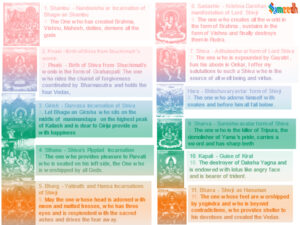The phrase “33 Koti Devatas” can be understood as referring to various categories or types of divine beings rather than a specific count of 33 crore deities. The concept of “11 Rudras” within the “33 Koti Devatas” in Hinduism refers to a specific group of deities associated with Lord Shiv.

The term “Rudra” is often used to refer to Lord Shiv in his fierce and destructive aspect. In Vedic tradition, Rudra is also considered a deity associated with storms, thunder, and healing.
Here’s more about the 11 Rudras:
- Ajaikapat: Ajaikapat is one of the forms of Rudra and is associated with creation and fertility.
- Ahirbudhnya: Ahirbudhnya is the serpent god and is often depicted as a protector of the Earth.
- Virupaksha: Virupaksha is known for his third eye and his ability to see beyond the ordinary world.
- Vilohita: Vilohita is often depicted with a red complexion and is associated with the dawn.
- Shambhu: Shambhu is another name for Shiva and signifies his benevolent and peaceful aspects.
- Kapardi: Kapardi is often depicted with matted hair and symbolizes asceticism.
- Raivata: Raivata is associated with wind or air and represents the cosmic breath.
- Mrigavyadha: Mrigavyadha is a hunter and is often depicted with a bow and arrow.
- Sarva: Sarva means “all” or “everything,” symbolizing the all-encompassing nature of Rudra.
- Bhava: Bhava means “existence” and represents the state of being.
- Bhairav: Bhairav is a fierce form of Shiv associated with destruction and protection.
These 11 Rudras are part of the broader group of deities in the “33 Koti Devatas,” which represents the vast and diverse spectrum of divine beings in Hinduism. It’s worth noting that the count and specific names of these deities can vary in different texts and traditions, but the core idea remains that they are manifestations or aspects of Lord Shiv in various forms and attributes.